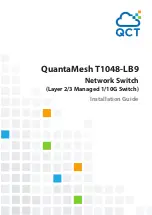
at the reference model network layer. Contrast with
bridge and gateway.
routing. (1) The assignment of the path by which a
message will reach its destination. (2) In SNA, the
forwarding of a message unit along a particular path
through a network, as determined by the parameters
carried in the message unit, such as the destination
network address in a transmission header.
RS-232. In data communications, a specification of the
Electronic Industries Association (EIA) that defines the
interface between data terminal equipment (DTE) and
data circuit-terminating equipment (DCE), using serial
binary data interchange.
S
server. (1) A device, program, or code module on a
network dedicated to providing a specific service to a
network. (2) On a LAN, a data station that provides
facilities to other data stations. Examples are a file
server, print server, and mail server.
session. The period of time during which a user of a
terminal can communicate with an interactive system,
usually, elapsed time between logon and logoff.
signaling. Establishment of an ATM connection from a
call set up by an end device.
Simple Network Management Protocol (SNMP). In
the Internet suite of protocols, a network management
protocol that is used to monitor routers and attached
networks. SNMP is an application layer protocol.
Information on devices managed is defined and stored
in the application’s Management Information Base
(MIB).
SLIP. Serial Line Internet Protocol.
SNMP. Simple network management protocol.
station. (1) A communication device attached to a
network. The term most often used in LANs is an
attaching device or workstation. (2) An input or output
point of a system that uses telecommunication facilities.
(3) An addressable node on an FDDI network capable
of transmitting, repeating, and receiving information. A
station has exactly one SMT, at least one MAC, at least
one PHY, and at least one PMD.
subnet. (1) In TCP/IP, a part of a network that is
identified by a portion of the IP address. (2) Synonym
for
subnetwork.
subnet address. In Internet communications, an
extension of the basic IP addressing scheme where a
portion of the host address is interpreted as the local
network address.
subnetwork. (1) A group of nodes that have a set of
common characteristics, such as the same network ID.
(2) Synonymous with
subnet.
summary address. An address prefix that tells a node
how to summarize reachability information.
SVC. Switched virtual connection.
T
TCP/IP. Transmission Control Protocol/Internet
Protocol
Telnet. In TCP/IP, an application protocol that allows a
user at one site to access a remote system as if the
user’s display station were locally attached. Telnet uses
the Transmission Control Protocol as the underlying
protocol.
TFTP. Trivial File Transfer Protocol.
token ring. A network with a ring topology that passes
tokens from one attaching device (node) to another. A
node that is ready to send can capture a token and
insert data for transmission.
topology. The physical or logical arrangement of
nodes in a computer network. Examples include ring
topology and bus topology.
trace. (1) A record of the execution of a computer
program. It exhibits the sequences in which the
instructions were executed. (A) (2) A record of the
frames and bytes transmitted on a network.
Transmission Control Protocol (TCP). A
communications protocol used in the Internet. TCP
provides a reliable host-to-host protocol between hosts
in packet-switched communications networks and in
interconnected systems of such networks. It uses the
Internet Protocol (IP) as the underlying protocol.
Transmission Control Protocol/Internet Protocol
(TCP/IP). A set of communications protocols that
support peer-to-peer connectivity functions for both local
and wide area networks.
transmit. (1) The action of a station in generating a
token, frame, or other symbol sequence and placing it
on the outgoing medium. (2) The action of a station
that consists of generating a frame, token, or control
sequence, and placing it on the medium to the next
station.
trap. Trajectory analysis program.
trunk. A physical topology, either open or closed,
employing two optical fiber signal paths, one in each
Glossary
169
Summary of Contents for 8265 Nways ATM Switch
Page 1: ...8265 Nways ATM Switch IBM User s Guide SA33 0456 01...
Page 2: ......
Page 3: ...8265 Nways ATM Switch IBM User s Guide SA33 0456 01...
Page 12: ...x IBM 8265 User s Guide...
Page 14: ...xii IBM 8265 User s Guide...
Page 16: ...xiv IBM 8265 User s Guide...
Page 17: ...Part 1 Configuring Your ATM Network Copyright IBM Corp 1994 1998 1...
Page 18: ...2 IBM 8265 User s Guide...
Page 38: ...22 IBM 8265 User s Guide...
Page 52: ...36 IBM 8265 User s Guide...
Page 90: ...74 IBM 8265 User s Guide...
Page 107: ...Part 2 Managing the 8265 Copyright IBM Corp 1994 1998 91...
Page 108: ...92 IBM 8265 User s Guide...
Page 134: ...118 IBM 8265 User s Guide...
Page 141: ...Part 3 Appendixes Copyright IBM Corp 1994 1998 125...
Page 142: ...126 IBM 8265 User s Guide...
Page 174: ...158 IBM 8265 User s Guide...
Page 178: ...162 IBM 8265 User s Guide...
Page 188: ......
Page 191: ......
Page 192: ...IBM SA33 456 1...








































